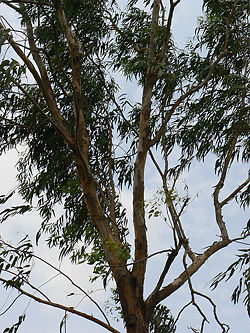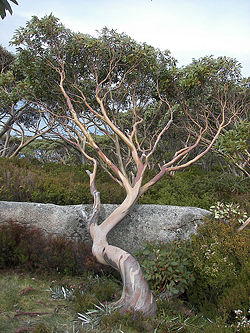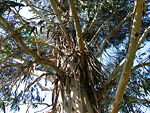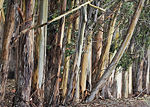Eucalyptus
| Eucalyptus |
|---|

|
| Scientific Classification |
|
| Species |
|
Contains 284 Species and 303 accepted taxa overall |
Eucalyptus is taxonomic genus containing hundreds of varieties of trees and a few shrubs. Most are evergreen, although a few tropical species will lose their leaves at the end of the dry season. It is most commonly found in Australia but can also be found in many other parts of the world. They are known to be messy and can easily start fires, however, it has many medical uses. The flowers and bark of a Eucalyptus are very distinguishable and beautiful.
Anatomy
The leaves of a Eucalyptus tree have four different noticeable stages: 'seedling', 'juvenile', 'intermediate', and 'adult'. Even though they are noticeable stages, there isn’t a distinct transition between stages. A Eucalyptus tree's leaves are covered with oil glands. The copious oil produced by these glands are very important to the genus of which Eucalyptus belongs. These plants have alternate leaves [1] which mean the attachment of the leaf is at a single node and that the leaves change direction throughout the stem. [2] They also appear waxy or glossy green. However, when the leaves are seedlings they are opposite, [3] which means they are paired together at the node. [4]. The young leaves, unlike the adult leaves, are not shiny. There are some exceptions to this pattern. Some species keep their juvenile leaves through out their whole life . In most species the leaves are in pairs that are directly across from each other on the stem. In some other species the leaves start out in pairs but than become a spiral arrangement. After the spiral stage, they go to a decussate arrangement, which is when they are directly across from each other. The flowers of a Eucalyptus are very noticeable. They are made up of many fluffy stamen. The stamen can be white, cream, yellow, pink, or red. When the flower is in bud, all the stamen are gathered in a cap called the operculum. The operculum is made up of petals, fused sepals, or both. While the stamen are expanding the operculum is pushed off and is split from the base of the flower.
They also have woody fruits or capsules called gumnuts. Gumnuts are shaped like cones and contain valves at the end. The valves at the end open up and release seeds. The bark of a Eucalyptus is different with different ages, the way it sheds, the length of the fibers, the degree of furrowing, and the thickness, hardness, and color. Once the tree is completely matured, they put a layer of bark on every year. This causes the stem or trunk to become thicker with age. Some species' outer layer of bark dies and than falls off, either in flakes or strips. These species are known as gums or smooth-barked. The bark will appear dull, shiny, satiny, or matt. Most Eucalyptus species are 'half-barks' or 'blackbutts'. These species contain their dead bark on the lower half of their trunk. It can also be collected in a thick, black chunk at the base of the tree. The bark of Eucalyptus have five different characteristics. Stringbark are long-fibers pieces of bark, Ironbark is very hard, rough, deeply furrowed, tessellated has many flakes of bark, box bark has short fibers pieces, and ribbon bark are loosely attached pieces of long thin pieces.[5]
Reproduction
Eucalyptus breed in mixed mating and have preferential outcrossing. They can self-pollinate but this is less efficient for the plant. Self-pollination leads to a reduction in capsule production, less seeds, and vigor seedlings. Eucalyptus are mostly pollinated by insects, animals, and birds. They start to flower in late spring through the middle of summer. However, it also varies greatly year to year. Almost half of a Eucalyptus' flowers don't mature. The development and maturation of their fruit is very short; it can be as short as four months. The Eucalyptus species rarely, if ever, store their seeds in the ground.[6]
Ecology
The Eucalyptus genus is mostly commonly found in Australia. No other continent is this limited to one genus. The reason they are so abundant in Australia is because how well they have adapted to that climate. Even though they are most commonly found in Australia the can also be found on the adjacent side of Indonesia and New Guinea. The farthest north they get is the Philippines Islands. Many Eucalyptus plants have been planted in the drier parts of California, Africa, Portugal, Spain, and South America.
Species can be divided into three main habitats and four size groups. Forest trees have one stem and consist of a crown that forms a small part of the tree's height. Woodland trees are also single-stemmed. They can appear to be multi-stemmed because they start to branch out very close to the ground. Mallees have multiple stems and are usually under 10 meters height. The crowns of these trees are found at the end of the branchlets. Other plants may combine with mallees to make a new formation. Some mallees are so low to the ground they could be considered shrubs. Most of these trees can be found in Western Australia. Because most Eucalyptus plants are not use to frost they need to live in a some what warm climate. They can tolerate mild frost, between -3 and -5 degrees Celsius. There is on species known as the Snow Gum that has tolerated -20 degrees Celsius. Most Eucalyptus in cold regions have been planted.[7]
Fire
Eucalyptus trees have been known to explode. When the weather is warm, the oils of a Eucalyptus rise, which is what, causes a bluish appearance. These oils are very flammable. These fires can spread very quickly considering all the other Eucalyptus oil has raised to the surface. Also, all the branches and bark that have fallen off the tree because of the fire are also flammable, which can cause an even bigger fire. These trees have adapted to sudden and occasional fires. Some species even depend on fire to spread and regenerate. Seeds start to sprout from underneath the ashes. Not long after fires Eucalyptus are able to regenerate. In 2003 there was a bushfire known as the Canberra bushfire of 2003. Many trees were killed but shortly after gum trees were starting to look healthy again. [8]
Health Benefits
Eucalyptus leaves can be used for varies reasons. One thing Eucalyptus has been used for is treating diabetes. It is commonly used to treat coughs and common colds by being found in lozenges, cough syrups, rubs, and vapor baths. Also, it can help soothe sore throats by aiding it to tea and gargles and can help cure bronchitis and sinusitis. When congested, ointments that contain leaves of a Eucalyptus are rubbed under the nose and to the chest because it loosens up phlegm. It is commonly recommended to inhale vapors because the help cure bronchitis, coughs, and the flu. It has even said to be used to revive someone if they have fainted because it has such a strong smell. Aroma therapists say to apply some to a cloth and place it under the fainted person. It can also be used to treat bad breath.[9]
Gallery
References
- Leaf wikipedia.
- Eucalyptus by USDA Plants
- Eucalyptus Wikipedia.
- Eucalyptus Water for a Healty Country
- Eucalyptus University of Maryland Medical Center







